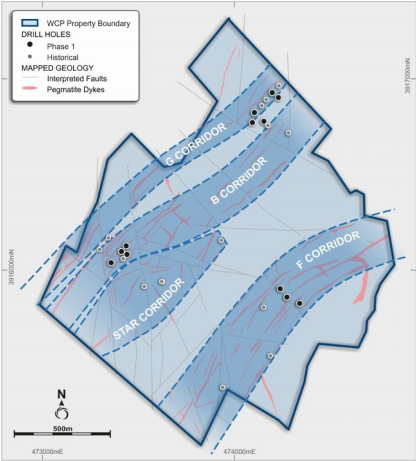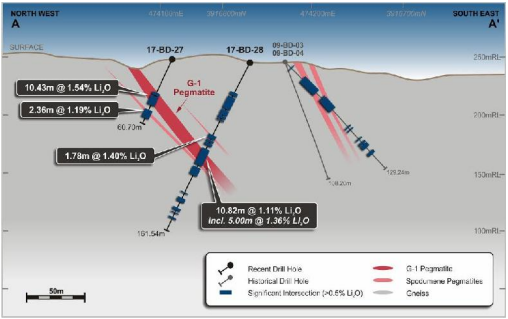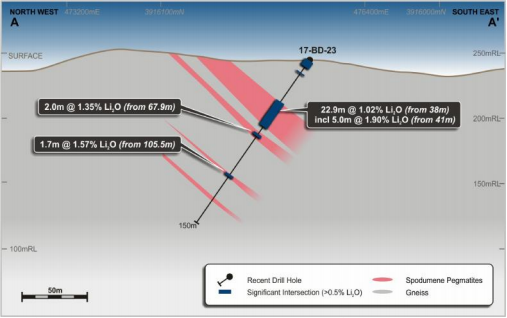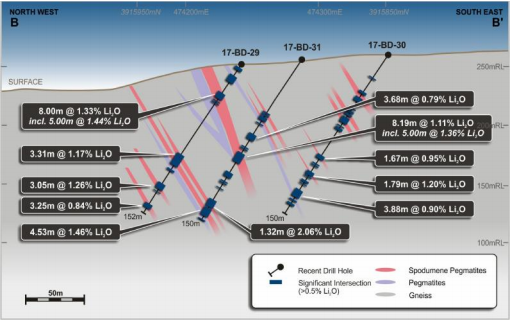PHASE 1 DRILLING CONFIRMS FOUR MAJOR HIGH GRADE LITHIUM CORRIDORS AT THE PIEDMONT LITHIUM PROJECT

ANNOUNCEMENT TO THE AUSTRALIAN SECURITIES EXCHANGE | May 23, 2017 | ASX:WCP
 170523_wcp_drilling_confirms_four_major_high_grade_lithium_corridors-1.pdf
170523_wcp_drilling_confirms_four_major_high_grade_lithium_corridors-1.pdf
- Further high grade lithium mineralization has been encountered in all of the final 7 holes from the Phase 1 drilling program at the Company’s 100% owned Piedmont Lithium Project, including:
- 19m of cumulative thickness of mineralization across 5 pegmatites which includes high grade zones of 5.0m @ 1.36% Li2O, 1.3m @ 2.06% Li2O and 4.5m @ 1.46% Li2O in hole 17-BD-31
- 19m of cumulative thickness of mineralization across 4 pegmatites which includes high grade zones of 7.0m @ 1.11% Li2O and 3.4m @ 1.53% Li2O within hole 17-BD-25
- 18m of cumulative thickness of mineralization across 4 pegmatites which includes a high- grade zone of 5.0m @ 1.44% Li2O within hole 17-BD-29
- Importantly, every hole drilled at the Project (31 holes in total) has encountered mineralization at shallow depths and has confirmed 4 major corridors totalling a cumulative strike length of over 4km, which remains open in all directions (Figure 1) The Company will now accelerate the Phase 2 drilling program to target these 4 corridors with the aim of delineating a maiden lithium resource estimate during the 2nd half of 2017

Figure 1: High Grade Lithium Corridors at Piedmont Lithium Project
WCP Resources Limited (“WCP” or “Company”) (ASX: WCP) is pleased to announce that high grade mineralisation has been confirmed in the final seven drill holes completed in its maiden Phase 1 drilling program at the Piedmont Lithium Project (“Project”). The Project is located in the world class Carolina Tin-Spodumene Belt (“TSB”), a historic lithium producing district in North Carolina, United States. The TSB is host to the Hallman Beam and Kings Mountain mines, historically providing most of the western world’s lithium between 1950 and 1998 and are along strike, to the southwest, 6 kilometres and 12 kilometres respectively from the Project.
Commenting on the results of the Phase 1 drill program Executive Director, Anastasios Arima, said “The drilling done to date within the Project area has been exceptional in yielding lithium mineralization in each of the 31 holes drilled, which are also consistent with the Project’s geological setting along strike from two of the largest historic lithium mines which were in production and their ores processed into lithium end products for over 40 years.
These results provide critical new data for planning of the much larger Phase 2 drilling program, which will now focus on the four major high grade corridors of mineralisation we have been able to identify.
We are now well funded and very well placed for an exciting second half of the year, with substantial news flow from a number of key exploration and development activities over the coming months”.
The final seven holes from the Phase 1 drilling program at the Project encountered thick zones of high grade mineralisation at shallow depths, with selected intercepts including:
- 19m of cumulative thickness of mineralization across 5 pegmatites which includes high grade zones of 5.0m @ 1.36% Li2O, 1.3m @ 2.06% Li2O and 4.5m @ 1.46% Li2O within hole 17- BD-31
- 19m of cumulative thickness of mineralization across 4 pegmatites which includes high grade zones of 7.0m @ 1.11% Li2O and 3.4m @ 1.53% Li2O within hole 17-BD-25
- 18m of cumulative thickness of mineralization across 4 pegmatites which includes high grade zones of 5.0m @ 1.44% Li2O and 3.1m @ 1.26% Li2O within hole 17-BD-29
- 15m of cumulative thickness of mineralization across 4 pegmatites which includes high grade zones of 2.4m @ 1.87% Li2O and 5.2m @ 1.56% Li2O within hole 17-BD-26
- 13m of cumulative thickness of mineralization across 2 pegmatites which includes a high- grade zone of 7.3m @ 1.39% Li2O within hole 17-BD-28
- 13m of cumulative thickness of mineralization across 2 pegmatites which includes high grade zone of 10.4m @ 1.54% Li2O within hole 17-BD-27
- 7m of cumulative thickness of mineralization across 3 pegmatites which includes high grade zone of 1.8m @ 1.20% Li2O within hole 17-BD-30
Results from the Phase 1 drill program together with the historical exploration highlight the potential for the Company to define a strategic, US lithium resource and becoming a key U.S. based developer of lithium raw material supply into the growing US domestic Electric Vehicle and Battery Storage markets.
The Phase 1 program consisted of 12 diamond core drill holes, totalling 1,662 meters. The results from the first five holes were previously reported on 3 April 2017. Results for the final seven holes are reported in this announcement. Significant, high grade mineralization was intercepted in all seven core holes with grades ranging from 0.90% to 2.06% Li2O. All significant intersections within the new drill holes, along with the details of the collar position, drill hole orientation and depth, are summarised in Appendix 1
Importantly, the completion of the Phase 1 drill program together with the historical drill program and exploration campaigns have allowed the Company to establish the presence of four major, high grade lithium corridors on the Project (Figure 1). On surface, these corridors are defined by semi continuous zones of outcrop, subcrop, and float blocks of mineralized pegmatite. The corridors, total in excess of 4 kilometres of mineralized trend within the Project. Approximately 85% of the 4+ kilometres are unexplored by drilling which will be the focus of the Phase 2 drill program. Each corridor has the potential to host high grade, thick mineralisation as was seen in the majority of the Phase 1 results. Further details on each mineralised corridor is explained below.
G Corridor
The G Corridor is the most north-western Corridor and is ~1.6 kilometres in length. It hosts multiple spodumene bearing dikes that have a northeast-southwest trend and dip moderately to the southeast. To date, only 10 holes have been drilled in the G Corridor with all returning mineralized intercepts; 9 of the 10 holes were focused within a 250-meter-long zone in the northeast portion of the corridor where historic drilling confirmed multiple mineralized pegmatite dikes and more specifically, the presence of a thick mineralized pegmatite which the Company has named the G-1 Pegmatite (Figure 2). The remaining single hole in the G corridor is located 970 meters to the southwest where 10-BD-16 intercepted high grade lithium mineralisation.

Figure 2: Cross-section of the G Corridor
The historic drilling suggested that the G-1 dike dipped moderately to the southeast. The Phase 1 objectives were to test the previous interpretation and confirm continuity along strike and down dip. Holes 17-BD-24 to 17-BD-28 targeted the G-1 dike with all holes intersecting the dike where expected. To date, the G-1 dike has been defined for 250 meters along strike and downdip to 100 meters. The G-1 dike remains open in all directions.
B Corridor
The B Corridor is a northeast-southwest trending corridor ~1.4 kilometres long. Drilling has confirmed that at least one set of dikes has a moderate southeast dip, however surface data suggests that other dike sets may have northwest and sill like orientations.

Figure 3: Cross-section of the B Corridor (Results reported in ASX announcement dated 3 April 2017)
To Date, 10 holes with the majority (7 holes) have been drilled in the southern portion of the Corridor. The Phase 1 drilling followed up on historical mineralized pegmatites intersected in 10-BD- 17, holes 17-BD-20 to 17-BD-23 (Figure 3) all intersected multiple mineralized dikes. The Phase 1 drilling tested and confirmed dike continuity for 140 meters along strike and 100 meters down dip and remains open in all directions.
F Corridor
The F Corridor is located in the South-East and is ~1.4 kilometres long. To date, 6 holes have been drilled and all intersected mineralisation. Initial interpretations for the results of 17-BD-29, 30 and 31 (Figure 4) suggest a southeast dip for the pegmatites, however a second set of dikes at a crosscutting orientation is possible.

Figure 4: Cross-section of the F Corridor
Star Corridor
Surface mapping confirms the spodumene bearing dikes have multiple orientations suggesting a more complex structural setting with the potential for very thick mineralisation. The drilling for this corridor consists of only five historic holes, all of which intersected mineralization.
The Phase 2 drill program will further enhance the understanding of each of the corridors and the pegmatites within them. The Company is confident that the Phase 2 drilling together with the Phase 1 and historical drill programs will form the basis for a maiden lithium resource estimate for the Project in accordance with the JORC Code, which is expected to be completed in the September 2017 quarter.
For further information, contact:
President & CEO (elect)
T: +1 973 809 0505
Executive Director
T: +1 347 899 1522
